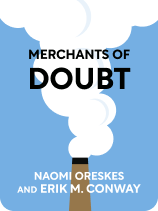

This article is an excerpt from the Shortform book guide to "Merchants of Doubt" by Naomi Oreskes and Erik M. Conway. Shortform has the world's best summaries and analyses of books you should be reading.
Like this article? Sign up for a free trial here .
How do people deliberately cultivate unhealthy, scientific skepticism? How do they create debate when an issue is already settled?
In Merchants of Doubt, historians Naomi Oreskes and Erik Conway look at some of the techniques that are used to stir up scientific skepticism. These doubt-mongering tactics have been deployed in several important “debates” such as tobacco use, nuclear disarmament, acid rain, the ozone layer, climate change, and the pesticide DDT.
Read on to learn how merchants of doubt sow seeds of detrimental scientific skepticism.
Doubt-Mongering Techniques
Merchants of doubt (MODs) are people or organizations who discredit science that threatens their agenda or ideology. There are 10 techniques that they use to cultivate scientific skepticism and create debate around issues that are scientifically settled. This appearance of debate can influence public opinion and delay or even halt regulation.
Technique #1: Emphasize Uncertainty
Merchants of doubt stir up scientific skepticism—playing up the natural uncertainty inherent in science to suggest that everything is uncertain, not just the details. If they can create a strong enough impression of uncertainty that people can’t even be sure there actually is a problem, they can delay policy and regulation.
Examples
- When scientists were studying the possible effects of a nuclear weapons exchange, the science was all based on projections because the only way to get evidence would have been to start a nuclear war and observe what happened. MODs claimed there was too much uncertainty around the possible consequences of an exchange to justify exposing the country to the dangers of disarmament.
- After scientists discovered that smoking caused cancer, there were still uncertainties, such as how exactly smoking causes cancer and why not all smokers get lung cancer (this is still unknown today). MODs tried to exaggerate these uncertainties into uncertainty about the whole question of whether smoking caused cancer.
- Climate modelers knew that their models had some uncertainty—for example, they couldn’t perfectly represent the effects of the ocean. However, they did know that the ocean effect wouldn’t be large enough to cancel out the warming. The MODs attacked the models for not considering all the factors.
Technique #2: Cherry-Pick Data
MODs cite or publicize only data that support their position and ignore anything that doesn’t.
For example, in 1989, the Marshall Institute (run by Jastrow, Nierenberg, and Seitz) put out a report that claimed the steady increase in atmospheric carbon dioxide couldn’t be responsible for global warming because the Earth’s surface temperature hadn’t steadily increased—there was warming before 1940 (before significant emissions), cooling from 1940-1975, and then more warming.
To support this, the report included a diagram that plotted CO2 against temperature. The lines didn’t match up particularly well, but that was because the MODs had only included part of the diagram. The full diagram was multiple graphs that plotted the effects of CO2, the sun, and volcanoes against temperature. Because all these factors affect surface temperatures, all of them had to be considered, and when they were, the temperature did line up.
Technique #3: Fund Other Studies in the Hopes of Getting More Favorable Results
If MODs don’t like what mainstream science has discovered about a subject, they often spend large amounts of money funding research that might “debunk” mainstream science or show that uncertainty is greater than previously thought. Sometimes they funnel the money through front groups or think tanks to disguise the connection.
For example, after scientists had determined that smoking caused cancer,the tobacco industry recruited Seitz to allocate $45 million worth of funding to scientists doing biomedical research on the leading causes of death in the U.S. The industry hoped for a discovery that would help them defend against the science that said smoking was unhealthy.
Technique #4: Create the Appearance of Debate in the Scientific Community
MODs recruit people with good credentials (including scientists) to challenge evidence and repeat non-consensus claims. They also put out publications that look like real scientific findings. This makes the public think that the scientific community as a whole is in debate.
Examples
- The tobacco industry recruited famous researcher Martin J. Cline to testify in its favor against a nonsmoking flight attendant who had gotten lung cancer from secondhand smoke in airline cabins.
- The CFC industry sent Richard Scorer, a professor of theoretical mechanics, on a tour of the U.S. to denounce a Climate Impact Assessment Program (CIAP) study. Scorer spread misinformation: Human activities were so small as to have a negligible effect on the atmosphere and the discussion of ozone destruction was fear-mongering.
- Two MODs wrote an article and formatted it to look like the Proceedings of the National Academy of Sciences. (The National Academy of Sciences is prestigious and legitimate.)
Technique #5: Call for “Equal Time” and Balanced Media Coverage
MODs convince journalists that it’s only fair to present “both sides” of a story when there’s dissent. Some journalists don’t understand that dissenters already received fair consideration during the peer review process, and they feel both views deserve to be aired. Other journalists allow themselves to be schmoozed, and still others don’t have enough time before their deadlines to dig deep into the research.
In fact, “balanced” media coverage of science actually results in more–biased coverage because minority voices end up with proportionally more time than consensus ones.
Equal attention for all views makes sense only when applied to opinions. For example, two political parties might have differing views on an issue, so it makes sense to hear both. However, there is no opinion in science—it’s either right, wrong, or unknown.
For example, tobacco industry MODs threatened journalists with the Fairness Doctrine—an FCC rule in effect from 1949-1987 that TV journalists had to give equal airtime to both sides of controversial issues. As a result, journalists gave the same amount of coverage to the industry as the mainstream science finding that smoking kills.
Technique #6: Publish in Mainstream Media
Most scientific research is first published in scientific journals, which the average person doesn’t read. Therefore, if MODs can get their “facts” and views into mainstream media such as newspapers and magazines, those are the facts and views the public will see.
Examples
- When Fred Singer wanted to spread scientific skepticism about global warming, he published a piece in a popular magazine called Cosmos.
- In 1990, MOD Dixy Lee Ray published Trashing the Planet, a trade book easily available to the public and reviewed by mass media.
Technique #7: Deflect and Distract
MODs take public focus away from the real issue and direct it toward something else—often true or important, but irrelevant.
Examples
- In discussions about the cancer-causing consequences of tobacco, MODs brought up other causes of lung cancer.
- When merchandising scientific skepticism about the ozone hole, Fred Singer argued that there are plenty of causes of skin cancer besides UV radiation (the hole allowed UV radiation through). This was true, but irrelevant to the point that UV radiation causes cancer.
Technique #8: Claim the Solution is Worse Than the Problem
MODs claim that the solutions to issues science has unveiled will create more problems than the original issue. Therefore, it’s better not to act.
Examples
- After scientists announced that CFCs (chemicals used in refrigerators and aerosols) were destroying the ozone layer, MODs claimed that CFCs alternatives (which didn’t exist at the time) would be toxic, dangerous substances.
- After scientists discovered that sulfur emissions were causing acid rain, MODs wrote that controlling acid rain would have huge economic consequences.
This technique is supported by rational decision-theory analysis—if there are unknowns, the best course of action is usually to do nothing because acting has costs, and if you’re not sure you’re going to get any benefits, they’re not worth it. (Additionally, the costs are usually in the present and the benefits in the future.) This is part of why doubt-mongering works so well.
Technique #9: Attack Other Scientists’ Reputations and Accuse Them of Having Political Motivations
If a scientist discovers something a merchant of doubt doesn’t like, the MOD will often personally attack the scientist.
Examples
- MODs accused Rachel Carson, who revealed that the use of DDT (a pesticide) was damaging the environment, of being “hysterical.”
- MODs accused Benjamin Santer, who helped prove that climate change was caused by humans, of secretly editing an International Panel on Climate Change (IPCC) report and corrupting the peer review process. MODs and fact-fighters wrote that Santer admitted he’d doctored a report to make it fit political policy (he didn’t), tried to stop Santer from publishing a defense of himself, tried to get him fired, and contributed to the break up of his marriage.
Technique #10: Attack Science
The final technique is to call science that doesn’t support your position bad or junk science. MODs might make claims that scientists massaged the numbers or rigged the experiment to further their agenda.
For example, MODs accused the Environmental Protection Agency (EPA) of doing bad science on secondhand smoke. They claimed the EPA wanted to regulate so badly that it manipulated the science to support regulation.
Doubt-Mongering Ironies
There are two ironies related to the doubt-mongering techniques:
First, the means that merchants of doubt use to justify their ends conflict with their free-market values. Interestingly, many of the doubt-mongering techniques were used by communists, or enemies of capitalism—for example, the Soviet Union erased history with historical cleansing, and in Orwell’s 1984, the totalitarian government made up fake histories and destroyed any information it didn’t like. One tenet of the free market system working is that everyone has to have access to information; the MOD’s techniques deliberately misinform people.
Second, delays create a greater need for regulation. The worse the problems get (and they worsen as they’re not addressed), the more aggressively the government will have to step in to fix them. The MODs have likely prompted more extreme regulation than would have been necessary had they not interfered.
While healthy scientific skepticism plays an important role, some forms and degrees of doubt do not contribute to good science. It is important to understand the difference and identify the tactics that are used.

———End of Preview———
Like what you just read? Read the rest of the world's best book summary and analysis of Naomi Oreskes and Erik M. Conway's "Merchants of Doubt" at Shortform .
Here's what you'll find in our full Merchants of Doubt summary :
- How doubt-mongering techniques are used to discredit those who threaten a person or company's agenda
- The 10 most common doubt-mongering techniques
- Steps you can take to protect yourself from doubt-mongering






